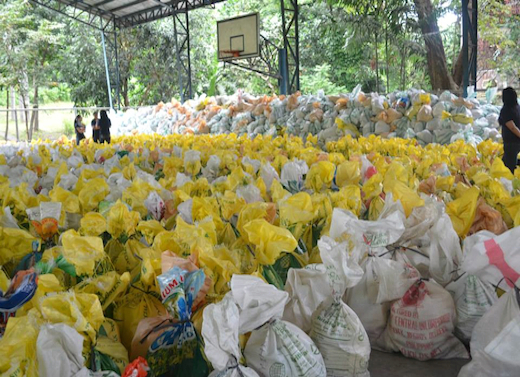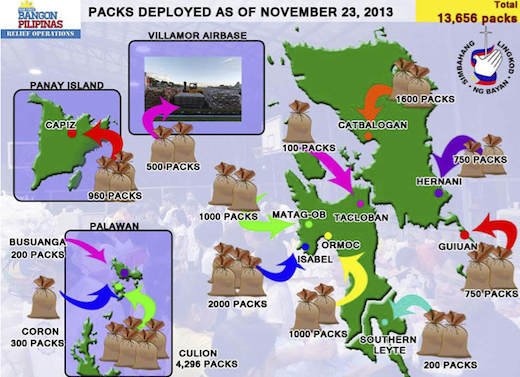Three weeks after Typhoon Haiyan (“Yolanda” in the Philippines) wreaked widespread devastation on the Philippines, the survivors are slowly beginning to pick up the pieces.
The official death toll of 5,500 as of November 27 makes the typhoon the deadliest storm in the country’s history – and the number of dead is expected to increase.
“We’re just waiting for the casualty report from Task Force Yolanda…[The death toll] should increase later today or tomorrow,” Defence Undersecretary Eduardo del Rosario, executive director of the National Disaster Risk Reduction and Management Council, said at a televised news conference.
The disaster panel said 1,757 people are missing and 3.54 million people are displaced because of Haiyan, which whipped up a 15-foot-high storm surge that drowned many people and affected close to 10 million people. More than one million houses were damaged. Government estimates put the cost of the damage at close to US$6 billion.
A Wall Street Journal article quotes a presidential spokesman saying that work has begun on bunk houses to shelter people left homeless by the storm in Tacloban, Palo, and Ormoc on Leyte island, and Basey and Marabut on Samar island. “At least 2,400 families will be resettled in this first phase,” he said, adding that the government is pushing hard to get affected areas back to normal. In Tacloban, 78% of the city has been cleared of debris, and public utilities are starting to operate in the city centre.

 Simbahang Lingkod ng Bayan (SLB), the social justice arm of the Jesuit Philippine Province, has also begun rehabilitation efforts. SLB swung into action shortly after Typhoon Haiyan struck on November 8 with an emergency relief programme, Bangon Pilipinas (Rise Philippines). Bangon Pilipinas rallied thousands of volunteers to pack and distribute food, water, clothes, and other relief supplies to more than 16,000 people in affected areas such as Culion, Tacloban, Leyte, Samar and Capiz.
Simbahang Lingkod ng Bayan (SLB), the social justice arm of the Jesuit Philippine Province, has also begun rehabilitation efforts. SLB swung into action shortly after Typhoon Haiyan struck on November 8 with an emergency relief programme, Bangon Pilipinas (Rise Philippines). Bangon Pilipinas rallied thousands of volunteers to pack and distribute food, water, clothes, and other relief supplies to more than 16,000 people in affected areas such as Culion, Tacloban, Leyte, Samar and Capiz.
On November 11, Philippine Jesuit Provincial, Fr Antonio Moreno SJ, issued an appeal to Jesuits communities for assistance to the victims of the typhoon. In his letter, Fr Moreno said the country was still reeling from the Zamboanga City siege and the earthquake that struck Bohol and Cebu in October, and with evacuees in those afflicted regions still homeless, new crises arise from people suffering as a result of the typhoon. In view of this and the long-term consequences, Fr Moreno asked the Jesuits to simplify any Christmas or other celebrations over the coming months in solidarity with victims and to give attention to the needed long-term recovery.
Jesuit communities across the world have responded to the appeal. “The support and solidarity of the different Conferences, Provinces, Regions and from Fr General himself have been extremely overwhelming and heart-warming,” said Fr Moreno. “Some even tapped their partners and other communities to assist. Others would like some long-term development programmes to assist affected communities. One Jesuit community is fasting for four Fridays, taking only water and bread. The would-have-been expenses for these meals will be sent to typhoon ravaged areas.”
With the emergency relief programme concluded on November 24, SLB is now finalising rehabilitation plans. These will largely be focused on Culion, Palawan, the Jesuit mission island that was once the world’s largest leper colony. Culion was the last place hit by the typhoon and, although it was little mentioned in the media, local contacts show that 3,750 families (15,518 individuals) were affected. More than 1,000 houses were totally destroyed and about 2,000 partially damaged.
SLB director Fr Xavier Alpasa SJ said a team will go to Culion on December 6 for community validation. They will look into rehabilitation prospects in housing, livelihood, purchasing of boats, renewable energy, psycho-social interventions and social entrepreneurship ventures.
The rehabilitation plan to be implemented in 2014 with a 3-year time frame includes the construction of houses and boats for the fishing communities; and education and training for jobs. There is also a plan to install solar panels for electricity. The typhoon caused total power failure on Culion, which only had 12 hours of electricity a day before. Power is estimated to be restored in January.
Simbahang Lingkod ng Bayan (SLB) through its Director, Fr Xavier Alpasa SJ, is coordinating all our efforts to assist victims of Yolanda.
Funds can be transferred through its bank (BPI [Loyola-Katipunan Branch], Peso Checking Account # 3081-111-61, Dollar Account # 3084-0420-12, Swift code should be BOPIPHMM, Routing #: 021-000-21). In the Philippines, cheques can be made out to Simbahang Lingkod ng Bayan, Loyola House of Studies, Ateneo de Manila University Campus, Loyola Heights, 1108 Quezon City.
The Philippine Jesuit Foundation (PJF) in New York also accepts donations. Please ask your contacts and friends to indicate in the memo “Yolanda Calamity Fund” to avail of the free service fee. PJF Donors can also earn tax credit for every donation made. Bank transfers in the US can be made through our Merrill Lynch bank (Account # 176-04A01). Checks in the US can be addressed to The Philippine Jesuit Foundation, PO Box 312, New York, NY 10028, USA, through Fr Victor R Salanga SJ.
In Australia, donations for the Philippines are being received at Jesuit Mission Australia. Go to http://www.jesuitmission.org.au/site/5/donations. Donations can be made online or by telephone, fax or post by credit card. Call +6129955 8585.
Donations made through JCAP will be channelled to where they can be most effective.
For more information on SLB’s rehabilitation work in support of Typhoon Haiyan survivors, contact SLB at slb.ph.

